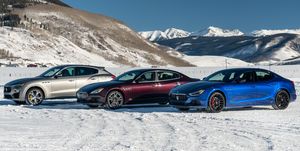View Photos

Andrew TrahanCar and Driver
There’s a phrase going around, one that everyone is sick of hearing, so we won’t repeat it here. However, it reminds us of what technology and globalization are doing to the car industry: consolidating the spectrum. There’s simply not as much difference today between the bottom rung and the top. You’ll find better steering in a four-cylinder Mustang than most BMWs. A $25,000 Hyundai can be had with many of the same luxury and convenience features as a Maserati Quattroporte. Digital design tools mean styling teams only churn out reserved styles as a matter of intent and not necessity.
So, how does a car company stand out? If you’re Maserati, you stand out because you’re Maserati. In the United States, you’re the only semi-attainable Italian car brand that isn’t the butt of jokes at least as often as it’s the subject of praise. The cachet in the Maserati name is one thing the Koreans can’t sell at a discount.
Discount Double Take
But if you’re Maserati, you consolidate your own spectrum. You obscure your own hierarchy by offering two sedans that are too similarly styled and sized. While we were parked in downtown Detroit shooting photos of our $126,805 Quattroporte S Q4 GranLusso test car, another white Maserati drove by. It wasn’t until it was past us that we realized it was actually a Ghibli, the Quattroporte’s smaller sibling that costs thousands less. You could blame the car’s white paint and bright sun and the fact that we forgot sunglasses that day for making the two models hard to differentiate, or you could blame Maserati for drawing two versions of the same car.
Not that we can fault them entirely. The Quattroporte is a beautiful standout deserving of mimicry. In a luxury class where the German mainstays all do proper and upstanding things like exude confidence and project stately reserve, the Quattroporte is a wild, seductive design. Its hood slopes dramatically down to a pinched ovoid grille, and its sweeping greenhouse is undergirded by a dashing bone line and voluptuously flared fenders. There’s more passion in this car’s rear door than there is in an entire Mercedes S-class.
But there’s more refinement in an S-class’s window switch than there is in the entire Quattroporte—particularly an all-wheel-drive model like the one tested here. At low speeds, the Q4 system binds and drags like a locked off-roader’s. Feed in the power, and you can feel the engine fighting against its own drivetrain to get things moving, but without much uptick in acceleration. Ham-fist it by stomping on the accelerator and cranking the wheel, and it wakes up. But nobody at Maserati is going to tell you this is supposed to be a hooligan machine. There’s a 523-hp twin-turbo V-8 Quattroporte GTS for that. And while the twin-turbo 3.0-liter V-6 in the S model makes a healthy 424 horsepower, that its exhaust sounds best only for the brief moments during the eight-speed automatic’s upshifts seems like obvious room for improvement.
Did Someone Say Room?
Speaking of room, there’s not so much of it in the Quattroporte. It is sized and priced like a BMW 7-series and a Mercedes S-class, but the space inside is more in line with the 5-series and E-class. While the Quattroporte we tested here had the $4000 Executive Rear Seat package, that option’s reclining rear seats seem intended more for spec-sheet parity with the Germans than for real comfort.
The Maserati Quattroporte is pretty inside, but so are all of its competitors. It offers a moderately more engaging driving experience, but so does the Ghibli. As the spectrum condenses, it’s getting harder to stand meaningfully apart from the herd. The Quattroporte is nothing so much as proof of that.
Source: Reviews - aranddriver.com









